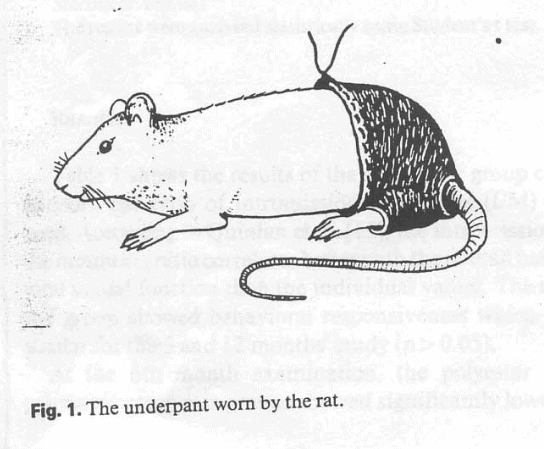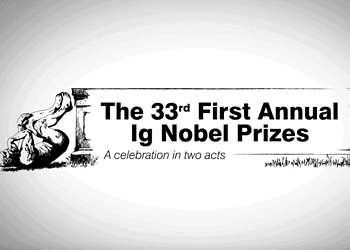The Ig Nobel awards show that not all good science has to be stuffy, serious, and sound important — or even seem rational.

Image credits AP.
We write about science every day. We read about it even more. But there’s only so much we can write and for every article we publish there are tens, hundreds or thousands of other findings that don’t make the cut.
Naturally, hard-hitting topics like dark matter, genetic editing, environmental disasters/breakthroughs and so on are favored. But science in itself isn’t about finding answers just to huge questions — science is about observing and learning from the world around us. All of it. Even something as weird as finding out what it’s like to be a goat or studying adverse effects of polyester underwear helps us make sense it all, holding meaning for science — though we tend to react to such findings with a shrug and a “huh” rather than genuine interest.
Thankfully, the Ig Nobel Prizes are here to celebrate such ideas.
Each fall since 1991, the editors from the Annals of Improbable Research pick 10 papers in a wide range of subjects — from physics or neuroscience all the way to entomology, acoustics, or safety engineering — and reward them for “unusual or trivial achievements in scientific research.” It’s all good-natured, if a bit tongue-in-cheek, but the winners are obviously flattered, not offended. This year’s winners flew in from five continents to pick up their awards: a clock with 61 seconds, a 10-trillion-dollar bill (from Zimbabwe), and a handshake from actual Nobel laureates such as Roy Glauber (physics, 2005), Dudley Herschbach (chemistry, 1986), Eric Maskin (economics, 2007) and Richard Roberts (physiology or medicine, 1993). Held at Harvard’s University’s Sanders Theather, the ceremony included a “mini-opera,” very short lectures topics such as fluid dynamics, a few “moments of science,” a tic-tac-toe tournament and the traditional tossing of paper airplanes.
While they usually hold a glimmer of criticism and satire, the prizes celebrate what I believe is the most important message in science — that even absurd-sounding topics can yield useful knowledge. As Ig Nobel Master of Ceremonies Marc Abrahams said, “Every winner has done something that first makes people laugh, then makes people think.”
So, without further ado, here are the year’s winning papers:
Reproduction: Having problems in the bedroom, guys? Well, you might want to start looking for a new pair of underwear. The late Ahmed Shafik from Cairo University’s Department of Surgery and Experimental Research found that undergarments woven with polyester significantly reduced the sexual prowess of male rats. In his paper, he describes how rats who wore 100% polyester underwear for a 12-month period were 87% less likely to succeed at an attempted sexual encounter than before. A 50-50 cotton-polyester blend dropped their success rate by 71%. All animals returned to normal after going commando for 6 months. The problem arises (or rather, doesn’t) because polyester garments generate an electrostatic potential in the genital area, averaging 443 volts/sq cm for 100% polyester and 239 volts/sq cm for the 50-50 blend. All-wool and all-cotton underwear had no measurable effect.
The paper was published in the journal European Urology in 1993.

Image credits Ahmed Shafik, (1993) European Urology, Effect of Different Types of Textiles on Sexual Activity.
Chemistry: Volkswagen’s engineers earned a tongue-in-cheek prize for turning the company’s cars into “clean diesel” vehicles. The organizers felt their efforts and success in designing a software that allowed its cars to perform in a low-emission mode while being tested but spew out illegal amounts of nitrogen oxide on the road needed to be rewarded. The EPA and California’s Air Resources Board exposed the scandal in 2015 — you can read about it here.
Economics: The award went to a team of researchers who showed that a smooth, dark rock has a distinct personality from a lighter, more rugged one. If you’re inclined not to believe that statement, you’re not alone — the team didn’t believe it either. They asked people to attribute personality traits to inanimate objects to point at flaws in the Brand Personality Five-Factor Model, a controversial marketing tool.
Their study was published in 2014 in the journal Marketing Theory.
Physics: Dark objects are more likely to emit horizontally polarized light than white ones. Several species of insects are attracted to such light, explaining why five species of dragonflies seek out black, flat, and shiny gravestones (they look like a water surface). It also explains why white-haired horses are the most horsefly-proof horses. This prize was awarded to two separate research groups.
The papers appeared in the journals Freshwater Biology and Proceedings of the Royal Society B.
Medicine: A team from the University of Luebeck, Germany, has proved that you can scratch an itch without ever having to touch it. In a series of experiments, they injected histamine dihydrochloride into the right arms of 20 volunteers to cause an itch. Then, they used mirrors and video feeds to make it seem to the volunteers that their itch was being scratched, while the researchers were scratching their unaffected left arms. While the illusion lasted, participants reported feeling less itchy.
The paper was published in 2013 in the journal PLOS One.
Psychology: How should we study lying? The winners surveyed 1,005 people ages 6 through 77 on how often they lied in the past 24 hours, and who they lied to. Their answers indicated that adults are the best liars and that people lie more often in their teens. Combined with the results of computer tests, the researchers concluded that lying varies with age. This suggests that people studying deception should include subjects from across the age spectrum instead of relying too much on college students. The team points out that not all answers were necessarily honest, though.
The study was published in 2015 in the journal Acta Psychologica.
Peace: A University of Waterloo and Sheridan College team investigated what makes people believe meaningless — but seemingly profound — statements, such as “Perceptual reality transcends subtle truth” and “Nature is a self-regulating ecosystem of awareness”. Using selected tweets “from Deepak Chorpa’s Tweeter account” they identified certain traits which makes people more susceptible to “B.S.” The paper, whose title I can’t actually post here but you should really check out cause it’s the best one I’ve ever seen on a scientific paper, included religious or paranormal beliefs, an embrace of alternative medicine, an interest in conspiracy theories, and lower “cognitive ability.”
It was published last year in the journal Judgment and Decision Making.
Biology: What’s it like to be something else, anything else than human? Can we actually know? Lawyer/bioethicist/veterinarian Charles Foster is the guy to ask. He tried living as a badger, fox, and a bird. He really got into it, making shelters in the dirt, dining on worms, or learning to navigate via smell alone. His experience is recorded in the book “Being a Beast”. Foster shared the award with Thomas Thwaites, who “took a holiday from being human” and lived with goats, as a goat. He even built a prosthetic rumen so he could eat grass. He published a book called “GoatMan”.
Literature: Entomologist Fredrik Sjoberg tells you everything you’d ever want to know about catching hoverflies on a remote Swedish island in his memoir, “The Fly Trap.” The Ig Nobel committee lauded the book for describing “the pleasures of collecting flies that are dead, and flies that are not yet dead.”
Perception: Japanese researchers Atsuki Higashiyama of Ritsumeikan University in Kyoto and Kohei Adachi of Osaka University studied why the world looks different upside-down. They recruited 15 volunteers and asked them to bend over, look through their legs and estimate the distance to five different objects. The guesses were compared to estimates made by upright volunteers who wore goggles that flipped their view 180 degrees. Their paper strengthened a theory known as the direct perception model.
The study was published in 2006 in the journal Vision Research.
Abrahams closed the awards ceremony with the traditional line
“If you didn’t win an Ig Nobel Prize tonight — and especially if you did — better luck next year.”






